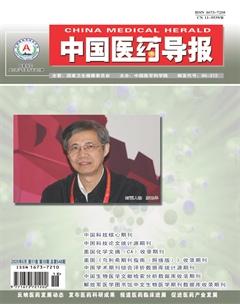经颅超声在帕金森病临床诊断中的研究进展
曹双双 王建伟 王展 马惠姿 冯涛
[摘要] 近二十多年来,经颅超声(TCS)检查越来越多地用于运动障碍性疾病的诊断及鉴别诊断。与其他影像学检查手段(如CT、MRI、PET)比较,TCS设备相对便宜、操作便捷、检查无创,值得推广。但TCS检查结果受多种因素影响,如受检者颞窗显示情况、黑质表现差异、检查者经验等因素,故检查结果的有效性存在争议。由于帕金森病的临床异质性较大,诊断帕金森病需结合临床表现及多种辅助检查。TCS检查可作为一种影像学标志物为帕金森病诊断提供辅助证据。本文详细描述了经颅黑质超声的检查方法、判定标准及可能机制,总结分析TCS在帕金森病的诊断、鉴别诊断及高危人群监测方面的价值,指出其局限性及改进方向,为今后更好地应用TCS检查提供帮助。
[关键词] 经颅超声;帕金森病;临床价值;局限性;改进方向
[中图分类号] R742.5 [文献标识码] A [文章编号] 1673-7210(2020)06(c)-0053-04
[Abstract] In the past two decades, transcranial ultrasound (TCS) examination has been used more and more in the diagnosis and differential diagnosis of movement disorders. Compared with other imaging inspection methods, such as computed tomography, as well as magnetic resonance imaging and positron emission tomography, TCS is worthy of promotion with the advantages of lower cost, more convenient and non-invasive operation. However, the results of TCS examination are affected by many factors, such as the patient′s temporal window display, the difference in the performance of the substantia nigra, the examiner′s experience and other factors, so the validity of the examination results is controversial. Due to the great clinical heterogeneity of Parkinson′s disease, the diagnosis of Parkinson′s disease requires a combination of clinical manifestations and multiple auxiliary examinations. Transcranial ultrasound can be used as an imaging marker to provide supporting evidence for the diagnosis of Parkinson′s disease. This paper describes the examination methods, determination criteria and possible mechanisms of transcranial substantia nigra in details. Furthermore, we have summarized and analyzed the value of TCS in the diagnosis, differential diagnosis and monitoring of high-risk populations in Parkinson′s disease, and pointed out its limitations with improving direction to help the better application in the further.
[Key words] Transcranial sonography; Parkinson′s disease; Clinical value; Limitation; Improving direction
帕金森病(Parkinson′s disease,PD)是最常見的神经系统变性疾病之一。PD的主要病理表现是黑质多巴胺能神经元变性缺失和路易小体(Lewy body,LB)形成。临床表现以运动迟缓、静止性震颤、肌强直为主要特征。PD诊断的金标准是死后病理诊断,临床诊断主要基于核心临床症状及药物反应性等。然而帕金森样症状并非PD患者所特有,且PD患者临床异质性较大,以上均对PD诊断带来挑战。为提高PD早期诊断率,众多生物学标志物被提出[1-2],包括临床症状、生物化学、基因学和神经影像学等。从Becker首次描述PD患者黑质回声增强(substantia nigra hyperechogenicity,SN+)以来,国内外大量研究报道经颅超声(TCS)可作为PD影像学标志物之一,为PD早期诊断提供辅助证据,并协助鉴别其他运动障碍性疾病。现对TCS在PD临床诊断中的研究进展作一综述。
1 经颅黑质超声检查(transcranial sonography of substantia nigra,SN-TCS)
1.1 操作方法
患者多取仰卧位,必要时也可取坐位。嘱患者先将头转向检查者对面,经耳前颞窗轴位扫描,在轴位上可发现被高回声信号的脚间池所包围的低或无回声信号的蝴蝶状中脑结构,缓慢向上移动10°~20°可探及第三脑室及周围结构。用相同方法对患者另一侧颞窗部位进行探查扫描。超声参数一般设置为:穿透深度14~16 cm,动态范围45~55 dB,频率2.0~3.5 MHz,根据需要调整亮度和时间增益补偿[3]。
1.2 经颅黑质超声的判定方法
1.2.1 黑质回声强度的判定 通常分为5级,Ⅰ级:呈均匀分布低回声;Ⅱ级:可见散在点状、细线状稍高回声;Ⅲ级:回声呈斑片状增强并低于脚间池回声;Ⅳ级:回声呈斑片状增强并等于脚间池回声;Ⅴ级:回声呈斑片状增强并高于脚间池回声。回声强度≥Ⅲ级视为SN+。
1.2.2 经颅黑质超声结果判定 Walter[4]回顾了SN-TCS的判定标准,有的以SN+面积较大侧为准,有的以双侧强回声面积平均值为准。多数研究以SN+面积≥0.25 cm2定义为黑质回声异常。Huang等[5]用黑质强回声面积/同侧中脑面积(S/M),发现约92.5%的晚发型PD患者S/M>7%,故将最佳阈值界定为7%。
1.3 SN+的病理机制
目前导致中脑黑质强回声的机制尚不清楚。多数研究[6-7]提示可能与铁沉积及神经胶质细胞增生有关。正常情况下,黑质中存在大量與蛋白结合的铁,病理情况下游离铁释放增多。有研究[8]通过检测PD患者血清和脑脊液中铁及相关蛋白的水平,分析其铁代谢特征,提示PD患者SN+与铁代谢异常有关,包括铁从周围系统向中枢神经系统的转运增加、细胞内铁释放减少及脑内铁沉积过多。Zhu等[7]研究发现,铁沉积及神经胶质细胞激活都有助于PD患者SN+形成,铁沉积及SN+与多巴胺能神经元坏死有关,而铁螯合剂去铁胺通过抑制SN+表现出神经保护作用。另外,苍白球中含有大量结合铁,但并不致异常回声增强,也提示SN+可能与游离铁增多有关。
2 TCS对PD的临床应用价值
研究发现84%~90%的原发性PD患者SN+[9-10],约10%的健康人群存在黑质强回声[3]。2013年欧洲运动障碍性疾病分会[11]建议TCS可用于以下方面:①PD与非典型帕金森综合征(APS)的鉴别;②PD高危人群监测;③PD早期诊断。
2.1 PD与APS的鉴别
临床上PD的鉴别诊断贯穿始终,尤其是病程早期,有时鉴别诊断非常困难。TCS检查可为PD与APS鉴别提供依据,但需结合颅内其他部位检查。SN+在PD患者中十分常见,而豆状核回声增强(LN+)和第三脑室增宽(3V+)在APS中常见[12-14]。Alonso-Canovas等[15]将PD、APS及健康人群对比分析,发现SN+对诊断PD的敏感性良好(80%),但特异性较差(61%)。若将颅内多个部位回声特征联合分析,如SN/LN、SN/3V、SN/3V/LN,可明显增高诊断特异性,但敏感性大大下降。以上提示单纯TCS检查对鉴别PD与APS的作用有限。需要指出的是,SN+可能在鉴别PD与非变性病(如特发性震颤ET)方面更有优势。Jesus-Ribeiro等[16]对比SN-TCS及123Ⅰ标记的DAT-PET扫描,对早期PD(H-Y分期≤2期)与ET患者进行鉴别,结果提示SN-TCS诊断PD的敏感性及特异性与DAT-PET相似。
2.2 PD高危人群监测
PD患者的一级亲属、PD相关突变基因的携带者更常见SN+,功能影像学检查显示以上人群中部分人18F标记的多巴胺摄取减少,说明已存在黑质纹状体功能受损[3]。多数研究[9,12]显示ET患者SN+发生比例较正常人群高,在15%左右。ET患者SN+是发展为PD的危险标志物[17]。抑郁人群发展为PD的概率较正常人群高,抑郁症患者在TCS检查时可见脑干中缝核信号减低或消失,而中脑黑质回声多正常。若患者存在抑郁状态且呈现SN+,则需警惕该患者的抑郁症状可能是PD的运动前期症状或PD本身的伴发症状[18-19]。
以上研究提示TCS检查可为部分PD高危人群监测提供帮助,但其对PD的预测价值仍待验证。Iranzo等[20]对55例原发性快速眼动期睡眠行为障碍(IRBD)患者随访5年,发现SN+的IRBD患者预测发展为突触核蛋白病的敏感性为42.1%,特异性为67.7%,阳性预测值为44.4%,阴性预测值为65.6%,提示单纯TCS检查并不是IRBD发展为PD的有效预测工具,且黑质强回声面积随时间变化不显著。
2.3 PD早期诊断
TCS检查对PD的早期诊断价值存在争议。与健康人群比较,SN-TCS检查是诊断PD的有效工具[21]。但在帕金森综合征患者中,TCS检查用于早期诊断PD的能力有限。例如与多系统萎缩(MSA)鉴别时,TCS检查可在一定程度上帮助区分非震颤为主型PD与多系统萎缩-帕金森型(MSA-P),但其鉴别特异性差,尤其是在疾病早期[22]。多项研究[23-24]用TCS与DAT-PET比较,结果提示TCS诊断PD的敏感性及特异性较差(64.7%~68.7%、40%~60%),提示TCS不能作为早期诊断PD的有效工具。需要指出的是,Alonso-Canovas等[25]对172例帕金森综合征患者随访3年,发现黑质回声正常的患者往往预示对多巴胺能药物反应不佳,或最终否定PD诊断。
笔者认为研究结果不一致的原因可能有:不同研究对TCS应用于PD诊断的鉴别对象不同,与非变性病鉴别时效能良好,与APS鉴别时效能下降;研究的样本量不同;更重要的原因可能是不同研究对SN+的界定标准不同,且SN+的判定与操作者经验及主观性有关。
3 TCS的局限性及新技术
TCS的局限性主要表現在以下方面:①部分受检者颞窗显示不良,亚洲老年女性检查失败率更高[26];②SN+的判定受人为因素影响:TCS检查时最佳切面选择与操作者经验有关;黑质回声强度判定存在主观性;计算SN+面积、中脑面积时存在人为误差。为突破TCS检查的弊端,近年来TCS新技术不断被报道。有研究[12,27]应用计算机自动分析系统,先将大量超声图像整合到软件中,当检查某位患者时,操作人员仅需标记出突出感兴趣区,计算机会自动测量相应区域回声强度,由此可实现对黑质回声强度的量化。近期一项研究[28]显示,将突出感兴趣区范围扩大到整个中脑时,其识别性能最佳。
TCS与磁共振联合(TCS-MRI)形成融合图像,可协助选择黑质强回声最佳切面,还可应用TCS将深部脑刺激(DBS)术后图像与术前MRI图像融合。Plate等[29-30]多次研究提示3D-TCS技术在经验不足的操作者中应用前景较大。通过3D重建,不但可以帮助寻找黑质回声最佳成像,同时减少因颞窗不良导致的检查失败(3D-TCS失败率为3.9%~4.3%,2D-TCD失败率为10%~20%)。我国复旦大学实验室[31]将经颅B超(TBS)与经颅多普勒超声(TDS)结合,组成多模式TCS检查,在检测黑质结构及回声强度的同时检测血流特征,从而提高TCS在PD诊断中的应用价值。
需要注意的是,TCS因其操作方便、无创、价格低廉等优势被广泛应用,对其改进时仍需保持其优势。TCS作为PD诊断的检查手段之一,可联合其他标志物特征和检查方法以提高临床应用价值。另外,仍需大样本循证医学研究来界定SN+的最佳判定标准。
[参考文献]
[1] Poewe W. Smelling Parkinson′s Disease:New Metabolomic Biomarker for PD [J]. ACS Cent Sci,2019,5(4):575-576.
[2] Lotankar S,Prabhavalkar KS,Bhatt LK. Biomarkers for Parkinson′s Disease:Recent Advancement [J]. Neurosci Bull,2017,33(5):585-597.
[3] Yilmaz R,Berg D. Transcranial B-Mode Sonography in Movement Disorders [J]. Int Rev Neurobiol,2018,143:179-212.
[4] Walter U. How to measure substantia nigra hyperechogenicity in Parkinson disease:detailed guide with video [J]. J Ultrasound Med,2013,32(10):1837-1843.
[5] Huang YW,Jeng JS,Tsai CF,et al. Transcranial imaging of substantia nigra hyperechogenicity in a Taiwanese cohort of Parkinson′s disease [J]. Mov Disord,2007,22(4):550-555.
[6] Jiang H,Wang J,Rogers J,et al. Brain Iron Metabolism Dysfunction in Parkinson′s Disease [J]. Mol Neurobiol,2017,54(4):3078-3101.
[7] Zhu Y,Wang B,Tao K,et al. Iron accumulation and microglia activation contribute to substantia nigra hyperechogenicity in the 6-OHDA-induced rat model of Parkinson′s disease [J]. Parkinsonism Relat Disord,2017,36:76-82.
[8] Yu SY,Cao CJ,Zuo LJ,et al. Clinical features and dysfunctions of iron metabolism in Parkinson disease patients with hyper echogenicity in substantia nigra:a cross-sectional study [J]. BMC Neurol,2018,18(1):9.
[9] Shafieesabet A,Fereshtehnejad SM,Shafieesabet A,et al. Hyperechogenicity of substantia nigra for differential diagnosis of Parkinson's disease:A meta-analysis [J]. Parkinsonism Relat Disord,2017,42:1-11.
[10] Bor-Seng-Shu E,Paschoal FM,Almeida KJ,et al. Transcranial brain sonography for Parkinsonian syndromes [J]. J Neurosurg Sci,2019,63(4):441-449.
[11] Berardelli A,Wenning GK,Antonini A,et al. EFNS/MDS-ES/ENS [corrected] recommendations for the diagnosis of Parkinson′s disease [J]. Eur J Neurol,2013,20(1):16-34.
[12] Walter U,?譒koloudík D. Transcranial sonography (TCS) of brain parenchyma in movement disorders:quality standards,diagnostic applications and novel technologies [J]. Ultraschall Med,2014,35(4):322-331.
[13] Bouwmans AE,Vlaar AM,Srulijes K,et al. Transcranial sonography for the discrimination of idiopathic Parkinson′s disease from the atypical parkinsonian syndromes [J]. Int Rev Neurobiol,2010,90:121-146.
[14] Richter D,Katsanos AH,Schroeder C,et al. Lentiform Nucleus Hyperechogenicity in Parkinsonian Syndromes:A Systematic Review and Meta-Analysis with Consideration of Molecular Pathology [J]. Cells,2019,9(1):1-9.
[15] Alonso-Canovas A,Tembl Ferrairó JI,Martínez-Torres I,et al. Transcranial sonography in atypical parkinsonism:How reliable is it in real clinical practice? A multicentre comprehensive study [J]. Parkinsonism Relat Disord,2019,68:40-45.
[16] Jesus-Ribeiro J,Freire A,Sargento-Freitas J,et al. Transcranial Sonography and DaTSCAN in Early Stage Parkinson′s Disease and Essential Tremor [J]. Eur Neurol,2016,76(5/6):252-255.
[17] Cardaioli G,Ripandelli F,Paolini Paoletti F,et al. Substantia nigra hyperechogenicity in essential tremor and Parkinson′s disease:a longitudinal study [J]. Eur J Neurol,2019,26(11):1370-1376.
[18] Walter U,Skoloudík D,Berg D. Transcranial sonography findings related to non-motor features of Parkinson′s disease [J]. J Neurol Sci,2010,289(1/2):123-127.
[19] Liu XJ,Zhang L,Zhang YF,et al. Echogenic alteration in the raphe nuclei measured by transcranial sonography in patients with Parkinson disease and depression [J]. Medicine (Baltimore),2018,97(50):e13524.
[20] Iranzo A,Stockner H,Serradell M,et al. Five-year follow-up of substantia nigra echogenicity in idiopathic REM sleep behavior disorder [J]. Mov Disord,2014,29(14):1774-1780.
[21] Toomsoo T,Liepelt-Scarfone I,Kerner R,et al. Substantia Nigra Hyperechogenicity:Validation of Transcranial Sonography for Parkinson Disease Diagnosis in a Large Estonian Cohort [J]. J Ultrasound Med,2016,35(1):17-23.
[22] Zhou HY,Huang P,Sun Q,et al. The role of substantia nigra sonography in the differentiation of Parkinson's disease and multiple system atrophy [J]. Transl Neurodegener,2018,7:15-22.
[23] Liu P,Li X,Li FF,et al. The predictive value of transcranial sonography in clinically diagnosed patients with early stage Parkinson′s disease:comparison with DAT PET scans [J]. Neurosci Lett,2014,582:99-103.
[24] Li DH,Zhang LY,Hu YY,et al. Transcranial sonography of the substantia nigra and its correlation with DAT-SPECT in the diagnosis of Parkinson′s disease [J]. Parkinsonism Relat Disord,2015,21(8):923-928.
[25] Alonso-Canovas A,Lopez-Sendon Moreno JL,Buisan J,et al. Does normal substantia nigra echogenicity make a difference in Parkinson′s disease diagnosis? A real clinical practice follow-up study [J]. J Neurol,2018,265(10):2363-2369.
[26] Zhou HY,Sun Q,Tan YY,et al. Substantia nigra echogenicity correlated with clinical features of Parkinson′s disease [J]. Parkinsonism Relat Disord,2016,24:28-33.
[27] Skoloudik D,Jelinkova M,Blahuta J,et al. Transcranial sonography of the substantia Nigra:Digital image analysis [J]. AJNR Am J Neuroradiol,2014,35(12):2273-2278.
[28] Fei XY,Dong Y,An HD,et al. Impact of region of interest size on transcranial sonography based computer-aided diagnosis for Parkinson′s disease [J]. Math Biosci Eng,2019,16(5):5640-5651.
[29] Plate A,Ahmadi SA,Pauly O,et al. Three-dimensional sonographic examination of the midbrain for computer-aided diagnosis of movement disorders [J]. Ultrasound Med Biol,2012,38(12):2041-2050.
[30] Plate A,Maiostre J,Levin J,et al. A baseline study for detection of Parkinson′s disease with 3D-transcranial sonography and uni-lateral reconstruction [J]. J Neurol Sci,2019,397:16-21.
[31] Shi J,Yan M,Dong Y,et al. Multiple Kernel Learning Based Classification of Parkinson′s Disease With Multi-Modal Transcranial Sonography [C]. Conf Proc IEEE Eng Med Biol Soc,2018:61-64.
(收稿日期:2019-11-21 本文編辑:封 华)

